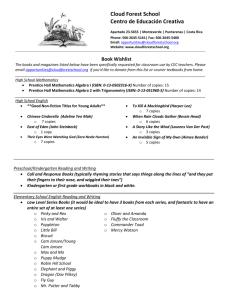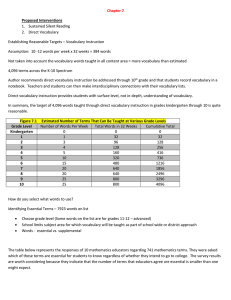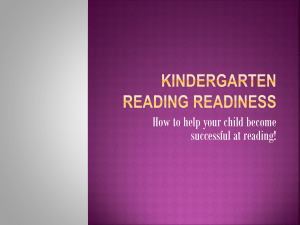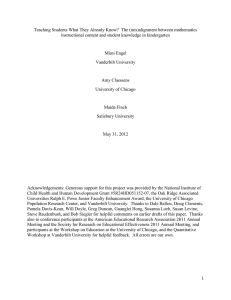Standards Guide for Parents Kindergarten Mathematics
advertisement
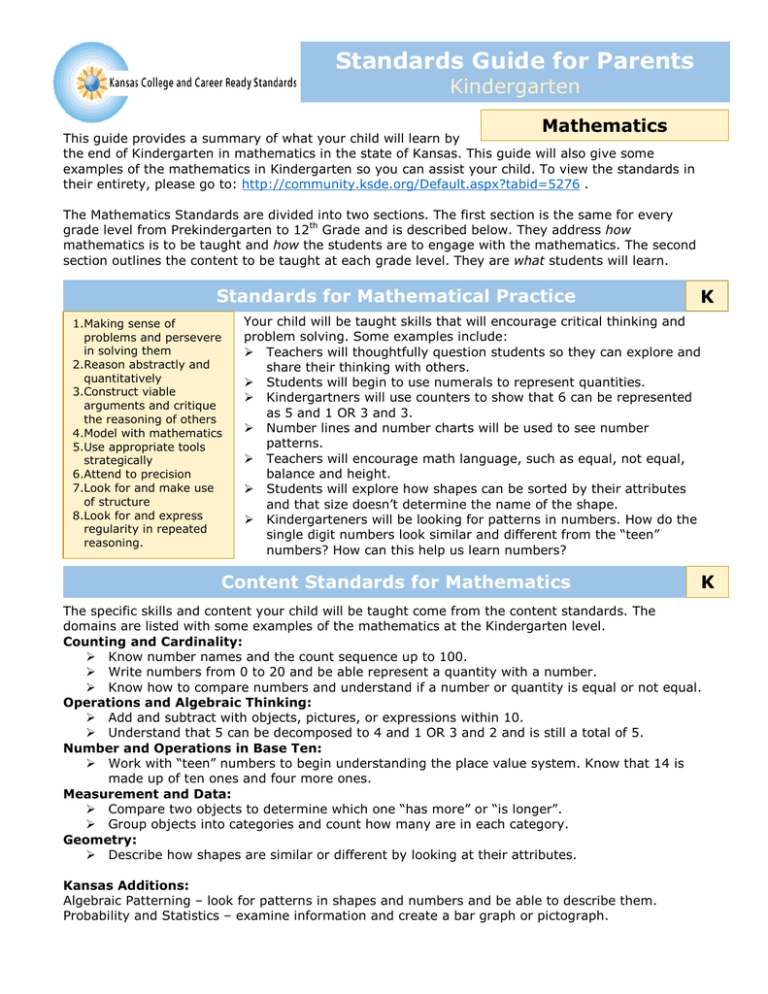
Standards Guide for Parents Kindergarten Mathematics This guide provides a summary of what your child will learn by the end of Kindergarten in mathematics in the state of Kansas. This guide will also give some examples of the mathematics in Kindergarten so you can assist your child. To view the standards in their entirety, please go to: http://community.ksde.org/Default.aspx?tabid=5276 . The Mathematics Standards are divided into two sections. The first section is the same for every grade level from Prekindergarten to 12th Grade and is described below. They address how mathematics is to be taught and how the students are to engage with the mathematics. The second section outlines the content to be taught at each grade level. They are what students will learn. Standards for Mathematical Practice 1.Making sense of problems and persevere in solving them 2.Reason abstractly and quantitatively 3.Construct viable arguments and critique the reasoning of others 4.Model with mathematics 5.Use appropriate tools strategically 6.Attend to precision 7.Look for and make use of structure 8.Look for and express regularity in repeated reasoning. K Your child will be taught skills that will encourage critical thinking and problem solving. Some examples include: Teachers will thoughtfully question students so they can explore and share their thinking with others. Students will begin to use numerals to represent quantities. Kindergartners will use counters to show that 6 can be represented as 5 and 1 OR 3 and 3. Number lines and number charts will be used to see number patterns. Teachers will encourage math language, such as equal, not equal, balance and height. Students will explore how shapes can be sorted by their attributes and that size doesn’t determine the name of the shape. Kindergarteners will be looking for patterns in numbers. How do the single digit numbers look similar and different from the “teen” numbers? How can this help us learn numbers? Content Standards for Mathematics K The specific skills and content your child will be taught come from the content standards. The domains are listed with some examples of the mathematics at the Kindergarten level. Counting and Cardinality: Know number names and the count sequence up to 100. Write numbers from 0 to 20 and be able represent a quantity with a number. Know how to compare numbers and understand if a number or quantity is equal or not equal. Operations and Algebraic Thinking: Add and subtract with objects, pictures, or expressions within 10. Understand that 5 can be decomposed to 4 and 1 OR 3 and 2 and is still a total of 5. Number and Operations in Base Ten: Work with “teen” numbers to begin understanding the place value system. Know that 14 is made up of ten ones and four more ones. Measurement and Data: Compare two objects to determine which one “has more” or “is longer”. Group objects into categories and count how many are in each category. Geometry: Describe how shapes are similar or different by looking at their attributes. Kansas Additions: Algebraic Patterning – look for patterns in shapes and numbers and be able to describe them. Probability and Statistics – examine information and create a bar graph or pictograph. Activities for Kindergarten One of the essential skills your child will work on in Kindergarten is subitizing. Subitizing means “instantly seeing how many” and is a foundational skill for understanding the properties of operations. If children only count one by one then they don’t learn to “chunk” quantities into small groups. You can help you child more fully develop this natural skill by trying the following games: Spill out a small group (start with 3 items and work up to 10) of beans, pennies, macaroni, or counters and have your child tell you how many there are in the group without counting. As the group gets larger encourage your child to “chunk” the items into smaller groups. When you see a small group of geese, bicyclists, or children, ask your child to tell you how many are in the group. Ask them how they grouped the items. Counting is an important Kindergarten skill, but when your child is proficient, try these activities: Start at a number different from 1. Count backwards. Have your child skip count by 2s, 5s, and 10s. Ask what comes before and after various numbers. Knowing the names of the numbers can be tricky for Kindergarteners. Fifteen and fifty sound very much alike! So when you and your child are counting you will want to be careful in how you pronounce these words. It can be helpful to have your child show you what the “teen” numbers look like with a group of objects (beans, macaroni, pennies). Have your child make a group with the ten and then a group with the rest of the ones. 13 Geometry Fun Many Kindergarteners believe that a shape changes just because it moves. Cut out a shape from a piece of paper (or use a napkin), place it on a table, and ask your child to name it (square, rectangle, triangle, etc.). Move the shape across the table and ask if it is still the same. Discuss with your child that the shape is the same. It changed places but it is still the same. Now put the shape “under” the table. Ask your child where you put the shape and if it is still the same shape. Continue moving the shape so your child can practice using the words over, above, behind, beneath, in front of, next to, etc. Comparing different measurements is fun and engaging for children. They are always wanting to know “who has more”, “which one is the tallest”, and “is that one bigger”. Take a couple of pieces of yarn, string or spaghetti sticks and lay them next to each other. Ask which one is longer, shorter, or if they are the same. When you have pieces that are the same, move one piece so that it is higher than the other and ask if the pieces are still the same length (if you child says “no” – put them back together so your child can see they are the same and talk about it).



